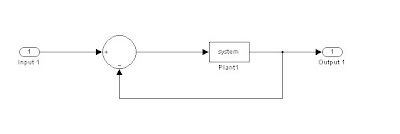As a controls engineer, it puzzles and irritates me when I either read an article or occasionally watch the news and hear some one describe a “negative feedback loop” and how it could worsen the state of the economy.
This is simply incorrect. In a post from today’s Economics Blog on the Wall Street Journal’s website, it does make the correction. However, it also mentions how many economists are using the term incorrectly, making it increasingly more common and tolerable. Aren’t these people supposed to be scientists?
There is no good excuse to simply take a term from another discipline, control engineering or system dynamics, and simply be ignorant about the correct usage and expect to overwhelm people with your ignorance and expect them to deal with it. It hurts your credibility. To say “Well, it would confuse the reader” is even worse. How about educating the reader? What if they saw the term used in another instance and were confused by that? Any one really interested in the term would hopefully do some research into its meaning.
Now, to educate: a negative feedback loop is simply a control engineer’s way of keeping a system from becoming unstable. See the figure below as an example of a simple negative feedback loop. What happens is that an input is brought in to the system, something is done to it in the “plant,” then the output from the plant is looped back (or fed back) and subtracted from the next value of the input. That’s where the “negative” part comes from. What this does is that it helps to keep the output from running off in one direction. It uses the value of the plant’s output to determine the plant’s next input.
 A positive feedback loop is almost exactly the same thing as a negative feedback loop, except that instead of subtracting the output of the plant from the next input, it is added. What this does is it deliberately creates an unstable system to drive the output to an extreme. See the figure below for an example. You might wonder why this would ever be used. It’s actually used quite frequently. One example is when the output can only be a 1 or a 0 (true or false). If the output ends up being 0.5 or something like that, the next part of the system (which takes the output from this system and does something with it) would be all confused. What would it do with a value in the middle? In reality, it’s actually worse. There isn’t any real “rounding” like that; there are regions that the output can be in to be a 0 or a 1, and it isn’t split down the middle. A value in between those regions would make things unpredictable. So, positive feedback is enabled to slam the output one way or the other (to a 0 or a 1).
A positive feedback loop is almost exactly the same thing as a negative feedback loop, except that instead of subtracting the output of the plant from the next input, it is added. What this does is it deliberately creates an unstable system to drive the output to an extreme. See the figure below for an example. You might wonder why this would ever be used. It’s actually used quite frequently. One example is when the output can only be a 1 or a 0 (true or false). If the output ends up being 0.5 or something like that, the next part of the system (which takes the output from this system and does something with it) would be all confused. What would it do with a value in the middle? In reality, it’s actually worse. There isn’t any real “rounding” like that; there are regions that the output can be in to be a 0 or a 1, and it isn’t split down the middle. A value in between those regions would make things unpredictable. So, positive feedback is enabled to slam the output one way or the other (to a 0 or a 1).
That’s control engineering in a nutshell. Most systems are way more complex than that, and how the “plant” is configured is a whole different ballgame. It’s the source of many great engineering discoveries and innovations, though. The obvious misconception is that the effect of the loop is the reason for it’s name. That’s simply not true. It’s just the math involved.
Happy National Engineers Week!
No comments:
Post a Comment